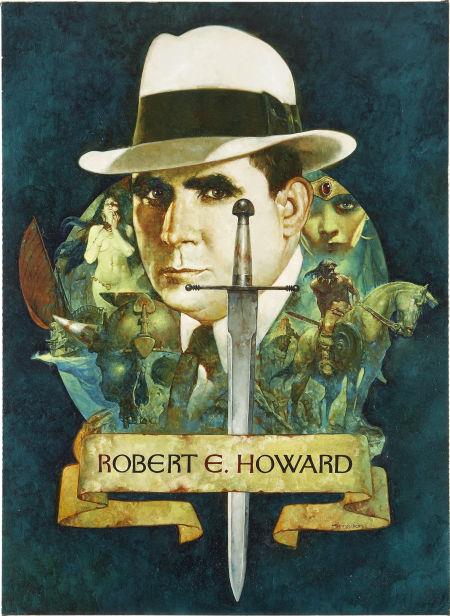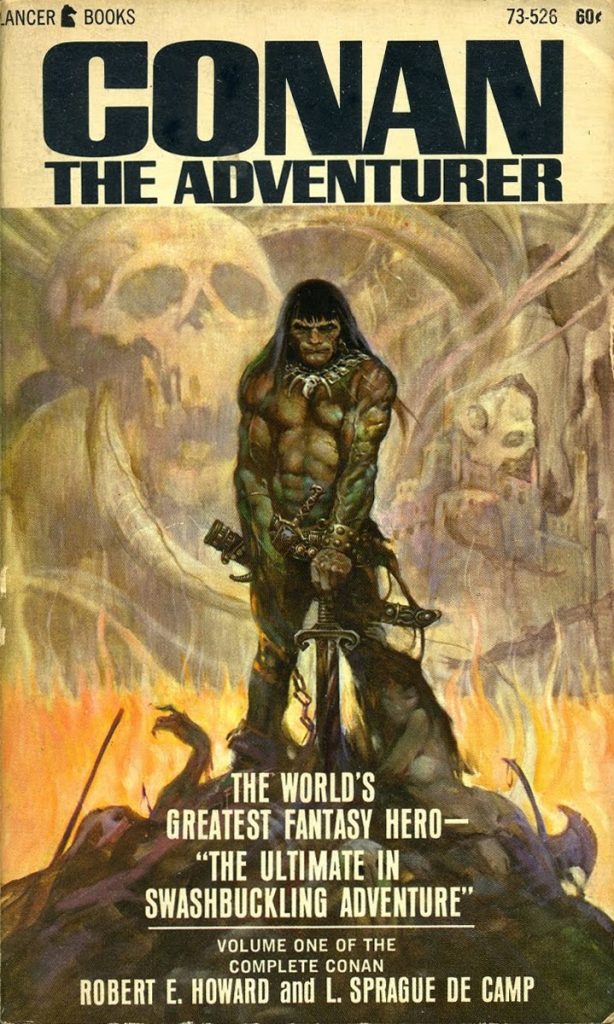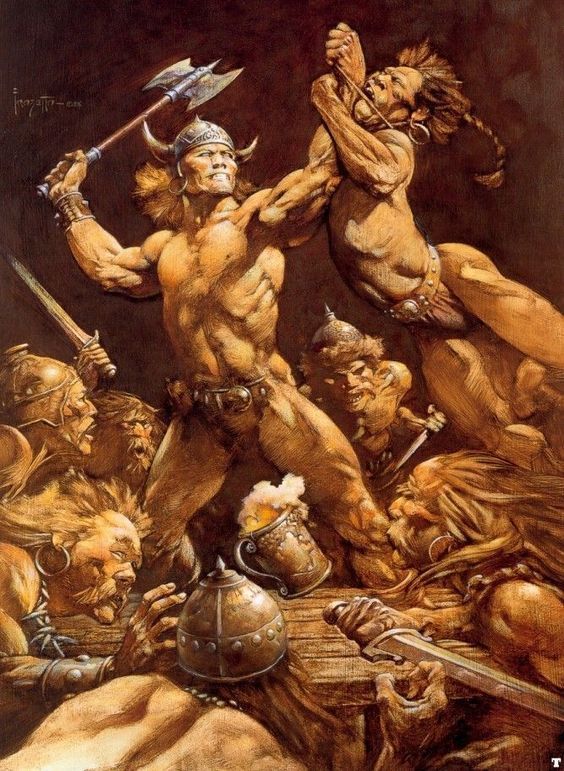
Where to Start With Robert E. Howard
by Bill Ward

Robert E. Howard (1906-1936) was a giant and a father to giants, his literary creations so potent that they have informed popular culture and permeated mass consciousness down to the present day. But their very ubiquity can obscure and deceive – if two people strike up a conversation about Conan, are they actually talking about the same Conan? What’s going on with all of these other writers penning stories of Howard’s heroes, and do they need to be read in order? Out of the dozens of reprints and collections over the years, just where do you actually start?
Because Howard’s creations are commercially valuable they have been distorted and, in my opinion, abused by various copyright holders, publishers, and editors over the years. While the full story of his publication history is well outside the purpose of this introductory essay (and not without plenty of bright spots to balance out some of the bad), there are a few salient points to keep in mind for the Howard novice. For one thing, differing copyright laws in various countries (specifically the US and the UK) sometimes mean that public domain versions of Howard’s stories are available for free (or cheaply repackaged in ebooks of potentially dubious quality) – and sometimes they aren’t. Often the stories are a less-than-desirable version. When it comes to many of the bargain basement editions of Howard, especially those in ebook, the old adage of you-get-what-you-pay-for applies in earnest.

There is also the confusion generated by the thriving Conan pastiche industry. Repackaging Conan over the years, presenting his story as a great epic complete with numbered volumes and an overall story arc, and ladling in a generous amount of filler stories penned by weaker writers or cobbled together out of unrelated and unpublished Howard stories (!), not only completely misrepresents the character, but raises a barrier of entry to the uninitiated. As a kid, I honestly thought I had to read the books in order, and since I’d only come across a few random volumes – none of them marked with that magic number ‘one’ – they just sat on my shelf, unread. Many assert that the deCamp and Carter pastiches opened the door to Conan for an entire generation of fans, and perhaps that’s true – but in my own personal experience, the door was shut tight, and the knob wouldn’t budge.
But everything else is good news. Did that old Howard collection with the frazetta-esque fantasy cover unexpectedly turn out to be boxing stories? Well, at least they are some of the best ever written in the genre. Was that ‘Conan’ story by Howard himself actually the tale of a 1930s pulp hero from Texas adventuring in the Middle East, with the guns swapped out for bows, and Afghans turned into Afgulis? Hey, it may not be true Conan, but it is good adventure fiction. As much as lesser talents interfered with the real thing, as much as the ticks flattered themselves that they were superior to the host, in the end the quality of Howard’s work always won out.

So where to start? Conan is of course synonymous with Howard, and with sword-and-sorcery itself. And anyone generally interested in reading Howard for the first time, is probably more than likely thinking of giving his Conan stories a try. The first that I always recommend to beginners is The Hour of the Dragon (also published as Conan the Conqueror) the one and only Conan novel from Howard himself. This short novel has all of the pace, energy, and invention of Howard’s magazine fiction, but in a longer adventure format that will feel more familiar to modern, novel-dominated reading habits. Howard even wrote the novel originally with a new audience in mind (the UK market), and it serves perfectly as an introduction to the character. Having lost his throne through trickery and treacherous sorcery, Conan goes on an epic quest that has him revisit the roles he occupied earlier in his career – pirate, reaver, mercenary, and thief. Everything that is hallmark to the Conan tales are found in this classic sword-and-sorcery novel.
The Hour of the Dragon/Conan the Conqueror has been published as a standalone volume over the years, but it is also included in the magnificent Del Rey line of Howard collections. Starting in 2005, Del Rey in the US began publishing first class collections of the unexpurgated Howard, following a trend begun by Wandering Star in the UK. These collections – currently at 11 volumes – feature the real, unadulterated Howard, his stories restored as close to the original published or unpublished versions as possible, and presented in the order in which they were written where applicable. Together with excellent supporting material from renowned genre scholars (including Tales From the Magician’s Skull’s very own Howard Andrew Jones), these volumes represent the absolute best entry into the world of Robert E. Howard.

The first three volumes present all the Conan stories, subsequent books focus on other famous characters of Howard, such as Bran Mak Morn or Solomon Kane, or collect stories according to theme, such as Howard’s horror tales and historical adventures. There are even a few ‘Best Of’ volumes that take a more grab bag approach, for those readers looking for the sample platter rather than the entree. And while I firmly believe the Del Rey series to be the absolute best of collected Howard – not only is it affordable and easy to find, but it is the best presentation of his work outside of small press editions – it of course is not the only place to find these tales. Regardless of which editions of Howard’s work you pick up, I’d like to present a few more specific recommendations for new readers.
In recommending specific Conan short stories, it’s tempting to list about half of the entire cycle, they are just so many strong pieces. One of the greatest sword-and-sorcery stories ever written is “The Tower of the Elephant,” a pitch perfect fast paced caper that treats us to the young Cimmerian rogue out of step with civilized ways, and more fundamentally decent than you might expect of a savage. A grizzled King Conan shines in the very first Conan tale “The Phoenix on the Sword,” as well as the story that probably served as the blueprint for The Hour of the Dragon: “The Scarlet Citadel.” And if you liked the battle at the end of that one, you’ll really love “Black Colossus,” where both Conan and Howard demonstrate a mastery of pitched warfare. Actually, it’s almost a rule of thumb that if the word ‘black’ is in the title, you’re looking at top shelf Conan – “Beyond the Black River” is Howard’s opus on civilization versus barbarism, “The People of the Black Circle” is a masterly novella with incredible pacing and a terrific villain, and “The Queen of the Black Coast” hits us with love and loss, as well as one of the most immortal sword-and-sorcery lines of all time:
“Let me live deep while I live; let me know the rich juices of red meat and stinging wine on my palate, the hot embrace of white arms, the mad exultation of battle when the blue blades flame crimson, and I am content.”

Other Howard heroes would not echo the above sentiment, and anyone suggesting they are clones of one another just isn’t paying attention. Both Bran Mak Morn and King Kull, Howard’s two other major sword-and-sorcery protagonists, are kings with a heavy doom laid upon them. Get a taste for both in the crossover story “Kings of the Night,” or journey through the dark side of Romano-Britain with Bran alone in one of the finest stories Howard would ever produce, “The Worms of the Earth.”

Howard also wrote historical adventure stories in the vein of popular tales from magazines like Argosy and Adventure. Many of the best are set in the backdrop of the Crusader period, where West and East collide in colorful conflict, such as in “The Sowers of the Thunder,” and “The Hawks of Outremer.” Or meet the real Red Sonya, a heroine who never once wore a chain mail bikini, not least of all because she’s living and fighting during the 16th century Siege of Vienna in “The Shadow of the Vulture.” And speaking of kick-butt heroines done right, you definitely won’t forget meeting Dark Agnes de Chastillon in “The Sword Woman.”
It’s perhaps easy to get the wrong idea about Howard’s fiction when you haven’t experienced the real thing, only the pop culture reflection, but the above basics certainly make for a great place to start. Howard’s output was broad, and it was vast – I’m not even mentioning his westerns, his humorous stories, his boxing yarns, or his poetry. Or how about “Pigeons From Hell,” an absolute classic of the horror genre. His possibly posthumously-finished sword-and-planet novel, Almuric? The El Borak adventures? And, I also have to point out that some of the Howard pastiche is actually quite good, so there really is a whole world of non-Howard Howard out there to discover as well.
No need to overwhelm new readers, the above taste is plenty. And once you’ve tried Howard, you certainly won’t need me to hold the door open for you any longer – you’ll shove me out of the way and kick it down yourself, just as any good barbarian would.






